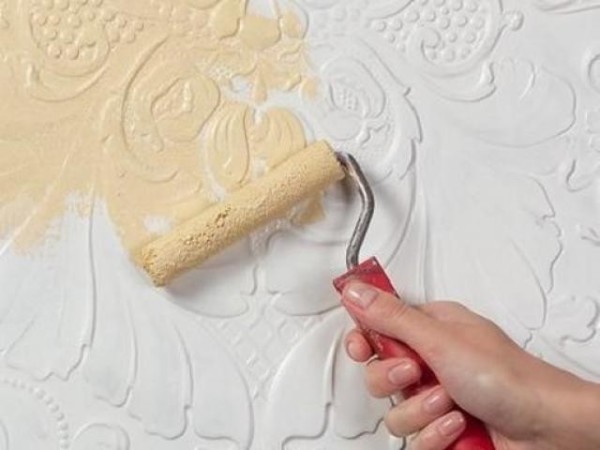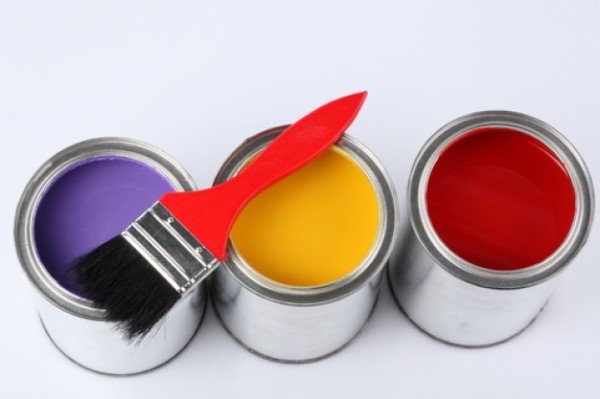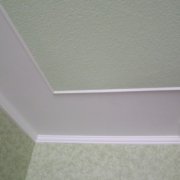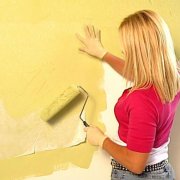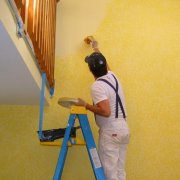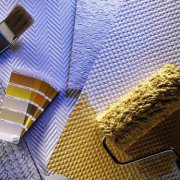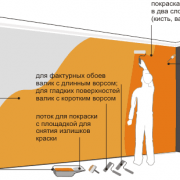How to paint wallpaper for painting without streaks
How to properly paint the wallpaper for painting, we will consider in detail. Indeed, today among the presented variety of decorating wall coverings, wallpapers occupy a leading position. They are distinguished by a variety of color options, textures, application techniques, functionality.
Each option transforms the room, making it cozy, if necessary functional. Wallpaper is our daily comfort. In the video in this article, you can see the individual moments of the work. After all, everything can be done with your own hands and then the price will not be significant.
The content of the article
Wallpaper for painting: primary and secondary
Coloring wallpapers provide additional advanced features. Such a surface can be turned into a work of art and the field of your imagination. The correct choice of the desired material option will make it possible for a long time to admire the result.
Wallpaper options for painting
For painting, there are wallpaper based on non-woven fabric, paper and glass wallpaper (see. Which is better: non-woven or cullet) Each of the types is completely individual, in the manufacture of has a special technology, composition. Each individually is applicable even to reusable dyeing.
They go on sale without previously applied layers of paint. There are color options, but they are light tones.
| Paper wallpaper | They are suitable for painting even for those walls that could not be carefully leveled. This opportunity is created due to the density and multi-layering of paper rolls.
|
| Thick non-woven wallpaper for painting | They do not crumple. Non-woven is the base that has the highest density.
|
| Cullet | Made of fiberglass threads. It includes sand, soda, dolomite, lime.
|
How and how to paint wallpaper under paint
In addition to choosing the right wallpaper, you need to pay attention to what paint to paint the wallpaper for painting.Not only the appearance, but also the service life of the coating will depend on this.
Caution: Water-based paints are suitable for painting wallpapers. Of the acrylics, only those that do not include solvents are suitable.
It:
- Water based paints can be matte, glossy, there are also semi matte.
- Glossy bright and clearly emphasize the texture and pattern wallpaperc, form a stable surface.
- The use of a matte version provides concealment of any irregularities and flaws of the walls.
- Be sure to think about what color to paint the wallpaper for painting, light tones will visually increase the room, and dark tones on the contrary will make it smaller.
Completing of the work
To glue the base, you need to purchase a roller with a fur nozzle, a tray, a brush, called a 50 or 80 cm fleitz, and paper tape.
Attention: Pay attention to the choice of the roller, because such a trifle can degrade the painting. The best option is with a long pile. It is enough to stain the entire necessary area.
So:
- Due to the elongated pile, the drawing is completely stained, while the short one captures only the surface from above. When choosing foam rollers, consider that they form paint bubbles, and therefore the appearance of the work will be damaged. The advantage of foam rubber is the ability to remove excess paint from the surface. Velor material also provides poor staining, as is the case with short pile fur.
- To paint over corners, use narrow brushes or short rollers.
Before starting work, you need to cover the floor with newspapers or other material in order to protect it from pollution. - To protect the skirting boards they are glued with paper tape. Remove it until the paint hardens to avoid material breaks.
- The number of layers applied depends on the quality of the paint. Some are applied in one layer and this is enough staining is performed carefully. Cheaper paints require two layers of application with drying of each previous. This is also taken into account when choosing the material for work.
Wallpaper coloring
Work with the material should be carried out in accordance with the requirements of the instructions. Dust removal of a surface before work is required. It is not worth it to wait a long time between the drying of the layers.
This may affect the adhesion of the material.
In some cases, the instructions require dilution of the paint with water. To do this, pour it into a larger bucket.
Attention: If dilution is not required, then before applying it is thoroughly mixed until uniform with a mixer or stick. Filtering will protect from solid undissolved suspensions. If paint remains after work, it is placed in a jar with a tight lid and turned over to remove any air. Thus, the paint will not dry.
Stages of application of paint:
- Brush or roller paint the top and bottom of the walls, corners. The application strips should be about 10 cm. This is required for further work by the roller, so that it does not go to an extra distance, dirtying other areas. Paint is applied in areas so that the wet layer does not interrupt.
- When drying, you need to take into account that the layers can overlap and thicken at the intersection and give a different shade. Therefore, you must try to prevent drying out.
- Paint may also rise. Such an undesirable effect is also achieved due to improper application of paint and uncontrolled drying. Example: a smear is applied that has not dried, but has become very thick. When applying the next layer, the tool can touch this edge with the edge and raise it. Therefore, strokes should be applied immediately, shading possible overlays.
- In hard to reach places it is not recommended to use a roller. Sockets, skirting boards and other elements are treated with a brush of the required thickness. This is done as you approach the required site.
- They work from the corner to the end of the wall.If 2 people participate, then each one works with his own.
- Do not use old, dried rollers. Such savings can spoil the appearance of the canvas, and all costs will be in vain.
- The new roller is first soaked in soapy water, squeezed and washed in clean. Thus, dropping out villi are removed. Then it is dipped in a container with poured paint (not completely, only dip).
To dip the entire tool in paint, a trick is needed. The paint tray has a textured grill. It is used to roll the roller and evenly apply paint on its entire surface. This cannot be done on a clean wall. Sometimes this procedure is required several times. As a result, the roller should be completely saturated with the solution and even begin to “champ”.
This step is carried out each time a paint is taken by a roller before further application. If the roller is not soaked, then unpainted areas are possible, and spots will form after drying. Repeated repetition of such requirements acquires dexterity as experienced painters who do this quickly and automatically.
- An impregnated paint roller rises and uniform rolling immediately begins. The uniformity of movements will ensure evenness, accuracy, obtaining one layer.
- Application movements are also important. It is recommended to visually draw the English letter W. The last movement is directed from the bottom up. Due to this, a thickening of the layer will not form from below. Without additional paint, the movements of the roller are directed horizontally, making shading.
- After working on one letter, another is immediately applied. At each stage of the work, one should not forget about the establishment of the rules for application, moisture layers, because the slightest flaw will spoil the work and costs.
- Wall paint is applied in parallel, vertically and from top to bottom. The width of the strips is approximately 70 cm. The room temperature and the drying speed of the layer can affect the width. It is necessary to ensure that the next time the roller does not go through the dry area.
- Of course, there are cases of drying. Experienced craftsmen use proven methods, tricks to get out of this situation. They, before painting the surface, increase the humidity level in the room. This can be done by placing a container of hot water about 30 minutes before starting work. Batteries must be covered with wet rags. Of course, such a procedure will facilitate work and improve the quality of work. Even an awkward smear can be repaired.
- Walls in a damp room are treated without worrying about drying out. Paint to lay down evenly. After work, water is removed, doors and windows are opened for ventilation. When airing, humidity decreases and the paint begins to dry better.
Caution: When increasing moisture, remember that moisture can have a negative effect on the wallpaper. Overdoing it can lead to peeling off the edges of the material.
- After working with the first layer, wait for drying, look at the result. If the effect does not fit, then a second layer is applied, and then a third may be required.
- You can highlight the relief of the picture using a velor roller.
For corners, take short rollers or flutes, but they are more difficult to work with. - Sometimes apply technology with the removal of the upper layer. To do this, use a foam roller. Such a tool is not suitable for primary staining, but copes well with the collection of paint.
- In this process, it is important to periodically rinse the roller and squeeze it well so that water does not get to the surface, forming bubbles. In this case, only the collection of paint is needed.
- After work, the paint is collected in a container, filtered. If it is supposed to work with a roller with the same paint, then they do not wash it, but only wrap it with a damp rag and place it in several bags. If you wash it, then increase the consumption of paint. After all, then again it will have to be well saturated.
- Wallpaper for painting may involve several layers of paint. It all depends on the picture. The last layer can even lead to a leveling surface.
Attention: Before buying a wallpaper, find out how many layers you can apply, because it may be necessary to apply a dye a second time. Think about what wall wear is possible, because if there are children or pets in the house, staining may not save. It may be necessary to replace old material with new.
- In public places, it may also be necessary to replace wallpaper, rather than re-staining, but in this case, more wear-resistant options should be selected for primary pasting.
Painting wallpapers is an interesting and entertaining process, because with a creative approach, you can use any paint to paint any picture. So it’s not worth the rush, look at the photo of the finished premises and select the desired design. The instructions will help you make no mistakes.
